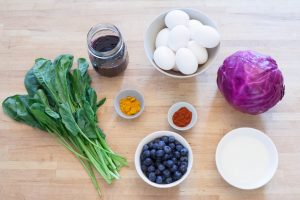Turning to nature for coloring Easter Eggs
University of Illinois Extension Services — March 31, 2021

Using the natural colors found in fruits and vegetables can create vibrant tones for dyeing Easter Eggs. (Photo courtesy of the University of Arkansas)
In many households, coloring Easter eggs is a wonderful family tradition, and with the invention of Easter egg dye kits, it’s easy to create fun egg art. But have you ever wondered how people colored eggs before packaged dye kits became available?
Eggs were dyed with natural ingredients, such as yellow onion skins, leaves of plants, and colorful berries. Just look in your fridge or pantry to see what natural egg dyes you have on hand, and start coloring!
Using natural dyes from foods, like beets or lemon peels, will be safe for eating after the Easter Bunny has laid them. Nevertheless, that convenient dye kit uses food-grade dyes so those eggs are safe to consume as well. However, unless you follow these simple rules, your dyed eggs could harbor bacteria in them, creating a not-so-fun Easter treat of foodborne illness.
- Wash hands thoroughly before handling eggs
- Do not color or hide cracked eggs
- Store dyed eggs in the refrigerator before hiding time
- Do not eat eggs that have been out of the refrigerator more than two hours
- Do not eat raw or undercooked eggs
If properly refrigerated, hard-cooked eggs in the shell are safe to eat within 7 days. Naturally dyed eggs tend to have a duller finish than commercially dyed eggs. For a soft sheen, rub with cooking or mineral oil after the egg has dried. Try getting creative by using rubber bands to create plaid and striped Easter eggs. It’s a fun time for the whole family!
Natural Egg Dye
2 handfuls of natural coloring agent (see table)
Water
1 Tablespoon white vinegar
Hard-cooked eggs in shell
Place natural coloring agent in saucepan and add enough water to cover 1-inch above coloring agent. Bring water to a boil, reduce heat and simmer for 15-60 minutes, depending on depth of color desired. Strain dye liquid using a cheesecloth or mesh strainer into a bowl or jar, deep enough to submerge the egg. Add vinegar. Wash boiled eggs with warm soapy water to allow the color to adhere more evenly. Allow to cool before coloring. Submerge eggs in dye, allow to sit until desired color is reached.
Natural Coloring Agent
Pinkish red — Fresh beets, cranberries, radishes or frozen raspberries
Yellow onion skins
Orange — Yellow onion skins
Delicate yellow —Orange or lemon peels, carrot tops, celery seed or ground cumin
Blue — Canned blueberries or red cabbage leaves
Beige to brown —Strong brewed coffee
Adapted from Michigan State University Extension







